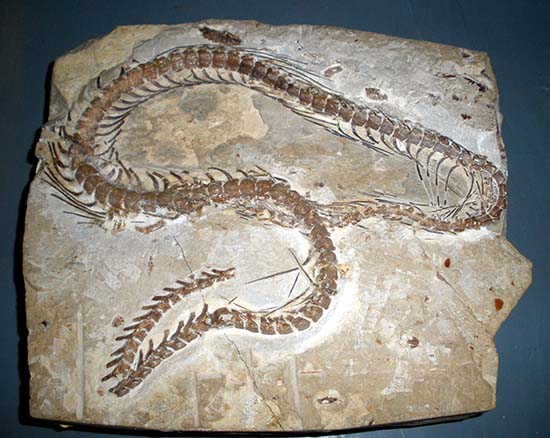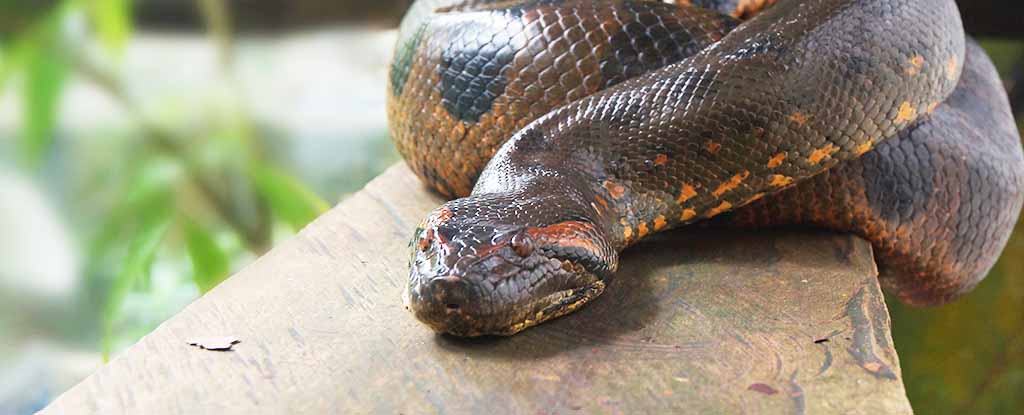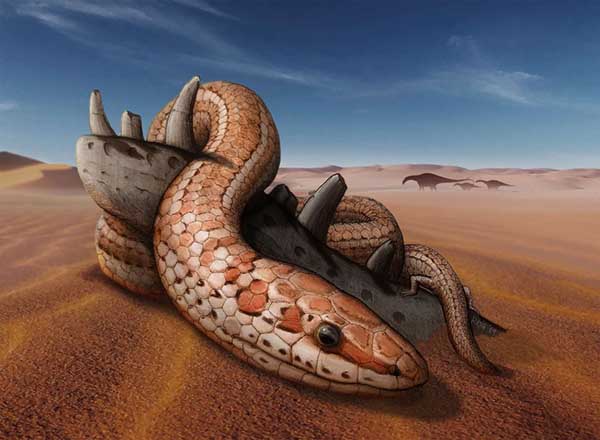

The fossil record of snakes is relatively poor because snake skeletons are typically small and fragile making fossilization uncommon. Fossils readily identifiable as snakes (though often retaining hind limbs) first appear in the fossil record during the Cretaceous period.
The earliest known snake fossils come from sites in Utah and Algeria, represented by the genera Coniophis and Lapparentophis, respectively. These fossil sites have been tentatively dated to the Albian or Cenomanian age of the late Cretaceous, between 112 and 94 Ma ago. However, an even greater age has been suggested for one of the Algerian sites, which may be as old as the Aptian, 125 to 112 Ma ago.
Based on comparative anatomy, there is consensus that snakes descended from lizards. Pythons and boas - primitive groups among modern snakes - have vestigial hind limbs: tiny, clawed digits known as anal spurs, which are used to grasp during mating. The families Leptotyphlopidae and Typhlopidae also possess remnants of the pelvic girdle, appearing as horny projections when visible.
Modern snakes greatly diversified during the Paleocene. This occurred alongside the adaptive radiation of mammals, following the extinction of (non-avian) dinosaurs. The colubrids, one of the more common snake groups, became particularly diverse due to preying on rodents, an especially successful mammal group. Read more ...
A Gigantic Snake Prowled India's Jungles 47 Million Years Ago Science Alert - April 19, 2024

A new analysis of fossilized vertebrae discovered in western India has revealed the existence of a giant snake species that may have measured some 11 to 15 meters (36.1 to 49.2 feet) in length when fully grown.
Beautifully Preserved Skull of 'Biblical Snake' with Hind Legs Discovered Live Science

On very rare occasions, an exceptional fossil is unearthed that provides an extraordinary glimpse into the evolution of a group of organisms. This time, it is the beautifully preserved skull of an ancient snake with rear limbs, Najash rionegrina. This and other new fossils help answer long-standing questions on the origins of snakes, such as how they lost their limbs and evolved their highly specialized skulls.
New fossils shed light on how snakes got their bite and lost their legs
The evolution of the snake body has captivated researchers for a long time - representing one of the most dramatic examples of the vertebrate body's ability to adapt - but a limited fossil record has obscured our understanding of their early evolution until now.
Baby snake 'frozen in time' gives insight into lost world BBC - July 19, 2018
The fossil of a baby snake has been discovered entombed inside amber. The creature has been frozen in time for 99 million years.
The snake lived in what is now Myanmar, during the age of the dinosaurs. Scientists say the snake fossil is unbelievably rare.
Four-legged snake ancestor 'dug burrows' BBC - July 24, 2015
A 113-million-year-old fossil from Brazil is the first four-legged snake that scientists have ever seen. Several other fossil snakes have been found with hind limbs, but the new find is estimated to be a direct ancestor of modern snakes.
The world's oldest known snake fossils: Rolling back the clock by nearly 70 million years PhysOrg - January 27, 2015
Fossilized remains of four ancient snakes have been dated between 140 and 167 million years old - nearly 70 million years older than the previous record of ancient snake fossils - and are changing the way we think about the origins of snakes, and how and when it happened.
X-rays Reveal Ancient Snake's Hidden Leg Live Science - February 8, 2011
A new look at a 95-million-year-old fossilized snake reveals two tiny leg bones attached to the slithery creature's pelvis. A three-dimensional reconstruction of the bones could help researchers understand how snakes evolved to lose their legs. The fossil, found in Lebanon, is from an era when snakes had not yet completely lost the hind limbs left by their lizard ancestors. A much-debated question among paleontologists is whether these leggy ancestors were ocean-living swimmers or land-dwelling burrowing lizards.
Largest prehistoric snake on record discovered in Colombia PhysOrg - February 5, 2009

Largest snake 'as long as a bus' BBC - February 5, 2009
The discovery of fossilized remains belonging to the world's largest snake has been reported in Nature journal. Titanoboa was 13m (42ft) long - about the length of a bus - and lived in the rainforest of north-east Colombia 58-60 million years ago. The snake was so wide it would have reached up to a person's hips, say researchers, who have estimated that it weighed more than a tonne.
Green anacondas - the world's heaviest snakes - reach a mere 250kg (550 lbs). Reticulated pythons - the world's longest snakes - can reach up to 10m (32ft).
 Ancient serpent shows its 2 leg BBC - April 10, 2008
Ancient serpent shows its 2 leg BBC - April 10, 2008
What was lost tens of millions of years ago is now found. A fossil animal locked in Lebanese limestone has been shown to be an extremely precious discovery - a snake with two legs. Scientists have only a handful of specimens that illustrate the evolutionary narrative that goes from ancient lizard to limbless modern serpent.
ANCIENT AND LOST CIVILIZATIONS